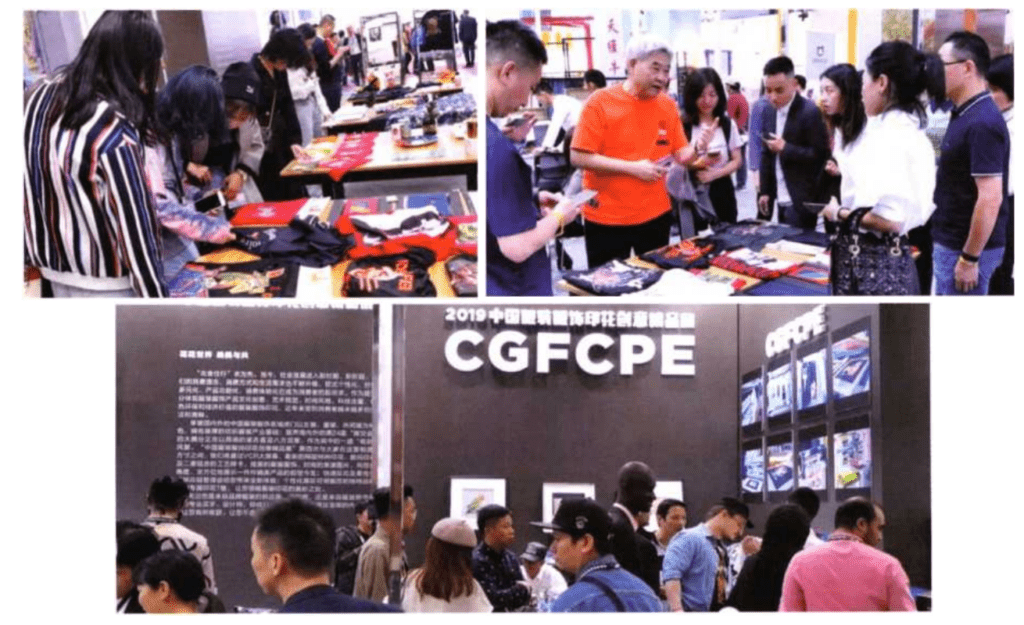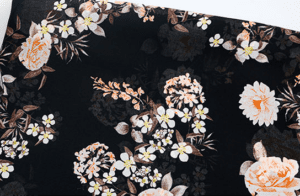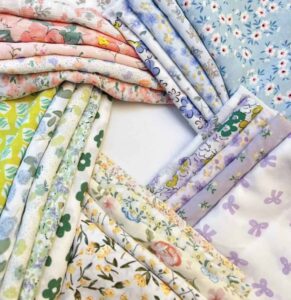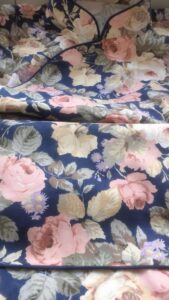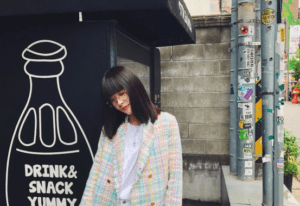clothing printing mainly refers to t-shirts, sweatshirts, casual clothing, knitted sportswear, children’s clothing, denim clothing, jumpers, individual pattern prints on garments or garments, but also knitted underwear, home wear, women’s clothing continuous pattern printing. The majority of fabrics are cotton weft knitted fabrics, while functional, modified and cotton- and linen-like polyester fabrics are gradually being used. Pieces and garments are generally printed with paint, gum paste, heat-set ink screen printing or digital ink-jet paint printing, which requires only heat to fix the colour after printing. Polyester fabrics are mainly printed with disperse dyestuff sublimation transfer, while natural fibres are mainly screen printed or digitally inkjet dye-printed.
Printing is an important part of the garment production chain and is developed along with the development of the garment industry. In 2019, as the garment industry enters a new round of restructuring and accumulation of development, printing enterprises will make structural adjustments and maintain a stable development trend overall, with a slight downward trend in output and an increase in small orders for multiple categories and complex processes; the pressure on enterprises will increase and the development trend will be to purchase automated equipment, improve efficiency, stabilise quality, develop new printing products and increase added value, and fine management to reduce costs. The trend is towards the acquisition of automated equipment to improve efficiency and stabilise quality, the development of new printing products to increase added value and fine management to reduce costs, fully reflecting the cultural, artistic, technological and economic value of printing on medium and high-end garments. The following are the highlights of garment printing in 2019.
Print new design becomes a competitive M-trick for companies
In the past two years, the general trend of garment printing orders is small batch, multi-species, each order as little as 100 ~ 200 pieces, printing process variety. In order to improve this situation, companies are developing complex, technically difficult and highly profitable new products, which are popular with branded and fast fashion garments, and the printing output and profits have increased significantly.
The combination of traditional screen-printing techniques and new materials and designs has led to the development of unique visual effects, which are popular with branded garments at home and abroad. The town of Shaxi in Zhongshan City, Guangdong Province, is outstanding, with leading printing enterprises developing two new products per week and no less than 100, for example, visual and tactile imitation , silicone floating just I:, hollow pressure Zuo, digital A printing special printing, perspective colour change variation change figure printing, embroidery car flower printing combination, etc., formed a comprehensive effect of arts and crafts. Although the printing process is complicated, costly and inefficient, and orders are only a few pieces, the market response is very good and the high profitability creates good economic benefits for printing enterprises.
Digital printing orders increased significantly
Oval latching flat screen printing machine + digital inkjet printing machine, has become the standard for large and medium-sized garment printing enterprises, run for the hand “flat screen printing machine + digital printing machine features spoon price advantage also gradually become the first choice of new and old garment printing enterprises. The application of digital printing equipment is increasing, and clothing designers are using more pictures and fine patterns in the design of their prints to improve the quality of their clothing products.
Screen printing + digital inkjet printing can solve the problems of high cost, low yield and unsatisfactory colour fastness of conventional inkjet white and colour ink. Digital printing currently accounts for around 20% of the total production of garment and garment printing, and will continue to grow. The use of digital printing in the apparel sector is being implemented on a large scale in China, and the equipment and techniques used are leading the way.
Printing automation equipment Entering the popularization stage
It is difficult for apparel printing companies to recruit skilled workers, and even more difficult to recruit skilled workers. Traditional hand-operated printing is unstable and inefficient. In the last two years, the automation and digitalisation of printing equipment has been gradually improved, with oval automatic flat screen printers becoming the upper stream of equipment for garment printing companies and entering the popularisation phase.China’s development of oval automatic flat screen printing machine began
In 2006, the last two years have gradually matured. According to statistics, manufacturing enterprises From 60 to 70 in 2018 to stabilize at about 40, can receive orders more often than on production of about 30 enterprises, produce enterprises main located in Rugao, Wuxi and Suzhou in Jiangsu Province, Guangdong Total production in 2019 was around 2,000 units, flat year-on-year, accounting for around 75% of the global total. In the last two years, the number of printing machine screen heads has generally increased from 16 to more than 2. If the number of printing heads is taken into account, the actual production has increased by 20% year-on-year. The annual output of oval automatic flat screen printing machines exceeds 200 units for 2 companies, 150-200 units for 2 companies, 50-100 units for 7 companies and 50 units for 19 companies. 25% of the total output is sold to Southeast Asia, the Middle East, Eastern Europe, South Africa and South America.
The production line with an annual production capacity of 500 sets of oval automatic flat screen printing machines will be put into operation in Rugao, Jiangsu Province in April 2020, and will be dedicated to building the world’s largest innovative technology body for the development, design, manufacture, application research, exhibition, demonstration, sales, technical service, new product development, training and exchange of oval machine series and related equipment. The company is also an innovative technology body for the development, design, manufacture, application research, exhibition, demonstration, sales, technical service, new product development, training and exchange of printing equipment; users will choose customised equipment according to the number of colour sets, print area, process, production, automation, intelligence and other requirements.
Clean production process starts to be used for garment printing
The dye digital inkjet printing production process of batch cloth requires the processes of sizing the cloth, digital inkjet printing, steam, washing, dewatering, drying ten, stentering and shaping, etc. The delivery time is long, which is not suitable for the current market demand of small batch, multi-species and fast response. Printing and dyeing science and technology workers after years of research and development, dye digital inkjet printing steam-free and wash-free cleaning function has been awarded a number of patents, the application of equipment and supporting consumables success, will gradually promote to the market. At present, there is a Guangzhou enterprise research and development of cotton fabrics, Hangzhou, an enterprise research and development of polyester fabric dye digital inkjet printing steam-free and wash-free clean production of two processes.
1, the main features
Printing bright colors, clear patterns, solid color, no steaming after printing, no washing, to achieve fuel inkjet printing complex production Ink directly sprayed on the fabric and the unique solid color permeability dyeing power, dye utilization rate increased, floating color reduction.
Process simplification, less investment in equipment, small footprint Reduce labor, reduce energy consumption Printed products comply with the requirements of GB 18401-2010 National Basic Safety Technical Code for Textile Products Achieved a rapid response to the dye digital inkjet printing
2. Process flow
Digital inkjet printing process with reactive dyes on cotton fabrics
Blank fabric – sprayed fibre treatment (100 g/m2 ) – digital inkjet printing with reactive dye – heat fixation (160-180 °C, 1 min) – finished product.
Digital inkjet printing process for polyester fabrics with disperse dyes
Fabric return – sprayed fibre treatment – digital inkjet printing with disperse dyes – heat setting (200 °C, 1.5 min) – finished product.
The cotton and polyester fibre fabric dyestuff digital inkjet printing steam-free and wash-free process not only achieves r clean production, but also solves the problem of small quantities of printed blood material for garment proofing, and small quantities of ten metres for rapid printing. At present, the cost of printing is 6 yuan for cotton fabrics and 2 yuan for polyester fabrics.
Production technology category: industry standard development by the enterprise attention
Garment printing enterprises are mostly small and medium in size, and over the years In order to change the backward situation of the garment printing industry, the National Technical Committee for Printing Standardisation (NTCPS) hosted the drafting of eight industry standards related to garment printing. In order to change the backward situation of the garment printing industry, the National Technical Committee for Printing Standardisation has drafted eight industry standards related to garment printing, which have played a positive role in regulating operational techniques and improving quality management. The industry standards that have been promulgated and implemented are F.
“CY/T 144-2015 Performance and test methods for the use of photopolymer for screen printing”.
“CY/T 146-2016 Requirements and test methods for the use of environmentally friendly water-based printing pastes for screen printing”.
“CY/T147-2016 Requirements and test methods for the use of polyurethane glue penal for screen printing”.
“CY/T 192-2019 Requirements and test methods for the production of screen printing stencils”.
“CY/T 193-2019 Requirements for the use and test methods of silicone for screen printing”.
“CY/T 196-2019 Screen printing tung garment paint printing process control requirements and test methods”.
“CY/T205-2019 Screen printing textile printing pigments pigment paste use requirements and inspection method〉〉.
At present, China’s testing of garment printing quality is based on safety tests in accordance with standards such as GB 18401-2010 National Technical Code of Safety for Textiles, but because there are no standards for printing quality, printing processing companies and garment customers are constantly disputing the quality of printing appearance, which often affects the progress of inspection and settlement times. In response to the needs of many garment and printing companies, the China Knitting Industry Association has taken the lead in approving the industry standard “Evaluation of the quality of printing on knitted garments”, which is currently being drafted.
Apparel printing enterprises gradually realize the important role played by standardization in the process of transforming from a weak to a strong printing country to a strong printing country, calling on enterprises to take the initiative to apply for much-needed standard items I, actively participate in the drafting: development work, and consciously implement standards.
The Rise of Garment Printing in the North
In recent years, the city of Haicheng in Liaoning Province has seized the opportunity of revitalising the old northeast industrial base and Xiliu Town being identified by the Liaoning Provincial Government as the first batch of provincial pilot projects to cultivate commodity markets combining domestic and foreign trade, and has cultivated and developed eight professional markets in Xiliu Town, with Xiliu Garment Market as the leader. Today, the Xiliu market cluster covers an area of 4.5 square km , with a construction area of 1.16 million n?, and 25,000 stalls, with garments as the market leader. Based on the Xiliu Garment Market, a large scale garment production and processing industry cluster has been formed in and around Haicheng, including printing and processing enterprises in the garment production chain.
There are nearly 400 printing factories of all sizes, plus a total of 600 garment printing enterprises in the surrounding areas of Zhaoxian, Yingkou, Dashiqiao and Liaoyang, with an annual output value of about 300 million yuan. The printing equipment mainly includes oval automatic flat screen printing machine, oval automatic flat screen + digital inkjet printing machine, oval automatic flat screen + digital inkjet printing machine, oval automatic flat screen + digital inkjet printing machine, oval automatic flat screen + digital inkjet printing machine, oval automatic flat screen + digital inkjet printing machine and oval automatic flat screen + digital inkjet printing machine.
The leading enterprises t£ move to develop new products to lead the Haicheng garment printing market, plucking doors + digital inkjet printing, high-frequency, embossing, digital stamping, lettering film transfer, seamless gluing and other process applications, almost synchronised with the developed Guangdong garment printing, to improve the grade and added value of Haicheng garments.
The increase in the number of enterprises producing garment printing and the technological progress in the city of Haicheng is a result of the development of garment production and the needs of the consumer market, but it is also related to the drive and influence of the leading printing enterprises in Xiliu town and the products and technical support provided by equipment and equipment dealers. The number of fans has reached 16,000 (8,531 + 1,722 in Raptor, 1,400 in ShakeYin, 1,300 in Volcano and 3,000 in WeChat’s circle of friends). The printing expert is making a contribution to small and medium-sized printing enterprises by improving their skills.
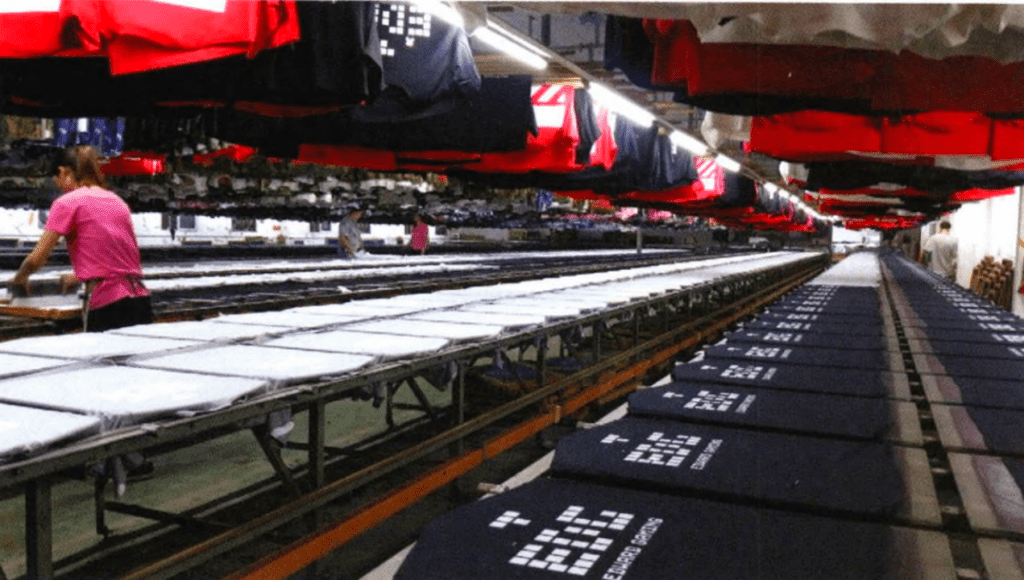
Cultural T-shirt consumption Promote the development of personalized customization
T-shirt is a weft knitting fabric short-sleeved shirt, divided into two kinds of lapel T-shirt and round neck T-shirt, wearing comfortable, convenient and clear price has made it the most worn garment by men, women and children worldwide. China is the world’s largest producer and consumer of T-shirts, with an output of about 51.6 billion pieces in 2016, accounting for 39% of the world’s total production, in recent years, by Vietnam, Bangladesh, India and other Southeast Asian countries with low labour costs, China’s T-shirt production and export volume is on a downward trend. As China’s national income increases, the per capita consumption of clothing continues to rise, and in 2018, the consumption of clothing grew At 10%, T-shirt consumption was the most significant increase, with the majority of the contribution coming from culture t-shirts.
Cultural T-shirts are short-sleeved, round-necked printed T-shirts with certain cultural elements, also known as cultural T-shirts, which express ideas, interests, hobbies and tastes through floral patterns or text, which are printed on the chest and back. Whether in sports shops, leisure wear shops, online shops, supermarkets, shopping malls, tourist areas or art trading platforms, cultural T-shirts with floral prints are being sold. As people’s living, working and shopping environments improve and their clothing habits change, the consumption of cultural T-shirts has increased significantly, with over 2 billion pieces consumed annually.
With the development of the cultural and creative industries, China has seen a rise in the personalisation of cultural shirts in recent years, which, although still in its infancy, has brought significant economic benefits to enterprises. For example, a company in Changshu with less than 10 employees has an annual output value of 10 million yuan; a company in Shanghai with a full production chain has an annual output value of 90 million yuan.
At present, individual customisation includes long-sleeved shirts, sweatshirts and hoodies, while team customisation extends to lapel shirts and sportswear, mainly in economically and culturally developed cities such as Shanghai, Beijing, Guangzhou, Shenzhen, Xiamen, Hefei, Liu’an, Chengdu, Wuhan, Changsha, Xining and Xi’an.
Among the five elements of cultural T-shirt personalisation – online platform, original graphics, printable T-shirts, digital printing and logistics – while the original graphics determine the value and sales of the T-shirts, the online platform is the key to success or failure, and many investors have failed in the development of the platform. A company in Shanghai, owned by an American group, has brought 25 years of global experience in C2M customisation to China to help companies realise personalised on-demand production, including a front-end customisation interface, a data processing centre (which analyses front-end sales data, product patterns, channel sales, amounts, product varieties and customer information to help companies plan) and an end-to-end production line. C2M systems. Consumers can place orders on mainstream online and offline C platforms (e.g. brand websites, Tmall flagship shops, WeChat mini-programs, physical shops, limited-time flash events, etc.) and use data to connect the front-end retail customisation platform with the back-end C2M customisation production platform.
With the gradual increase in apparel consumption over the next 10 years and the maturation of new supply chains under the new retail trend, cultural T-shirts will be based on the integration of physical shops, e-commerce and mobile internet to provide consumers with a better experience. Customisation experts estimate that the global consumption of personalised cultural T-shirts will account for 20%, with China’s annual consumption expected to reach 400 million pieces. Personalised consumption will become more and more trendy as people become more aware of themselves, and the teenage generation is a huge potential consumer market for cultural T-shirts.
Environmental protection becomes a survival pointprinting companies
The ‘dry printing’ process referred to in the report is mainly screen paint printing, gum paste printing and digital inkjet paint printing, all three of which are actually paint printing processes. All of these printing processes use water-based, environmentally friendly materials and the finished product is only heated and fixed after printing. Although no steam or washing is required after printing and no printing effluent is generated, a small amount of effluent is generated during the cleaning of the printing stencil, squeegee, printing table, colour paste container and plate development, and some waste gas is generated during drying and colour fixing after printing.
Paint printing is a process in which colours are mechanically adhered to fabrics using a cross-linked film-forming binder. The pollutants in paint printing wastewater are mainly printing pastes and the physicochemical properties of the wastewater are related to the composition of pigment pastes, binders and thickeners in the printing pastes.
Pigment pastes are pastes made from water-insoluble organic pigments ground in glycerine, with a small amount of dispersant and defoamer added due to the production process. The binders are water-soluble polymers with cross-linked functional groups, mainly consisting of polyacrylic acid, polypropylene cyanide, polypropylene amide, polyurethane and a small amount of initiator. Thickeners are water-soluble polymers with high molecular weight, such as modified cellulose urea. Paint printing wastewater has a high turbidity due to the use of different coloured pigments and is treated by natural sedimentation after multi-stage sedimentation and mixing. The exhaust gases from the drying and colour fixing of paint printing mainly come from the VOCs (Volatile Organic Compounds) released by the various dyestuff auxiliaries and printing coatings used in the bleaching and dyeing of blank fabrics and functional finishing, which are mainly volatile gases such as formaldehyde, polyphenols and aromatic cones.
At present, China’s policies and regulations on environmental protection are becoming stricter and stricter, especially for printing and dyeing enterprises. Many enterprises cannot add equipment simply to increase their production capacity, as this is not conducive to the stable support and development of the garment supply chain. Many companies are calling for relevant institutions to test the ‘three wastes’ generated by ‘dry printing’, to determine the extent of the impact on the environment and to propose measures to combat it in accordance with national and local environmental protection policies, in order to facilitate the normal development of garment printing.
Fine Print Exhibition Become a platform for learning and exchange
As a means of reflecting the culture, art, fashion, technology and economic value of clothing and apparel products, printing can meet people’s new demand for higher quality, more functional and personalized products in the new era, further play the unique role and market value of clothing and apparel printing, stimulate the development and production of advanced “a” technology and creative and innovative products, showcase the image, strength and level of enterprises, and promote the effective connection and deep integration of the upper and lower reaches of the clothing and apparel printing chain. It can further develop the unique role and market value of garment printing, stimulate the enthusiasm for the research and development and production of advanced technology and creative and innovative products, showcase the image, strength and level of enterprises, promote the effective connection and deep integration of the upper and lower reaches of the garment printing chain, and create new advantages in the international competition of China’s garment printing industry.
The 19th Golden Screen Award competition was held at the Shanghai New International Exhibition Centre in Shanghai, China, on the occasion of the 2019 Asia Pacific Screen Printing & Imaging Exhibition/2019 China International Screen Printing & Digital Printing Exhibition. Of the 135 entries, 77 were textile prints, accounting for 57% of the total number of entries, including 42 garment prints (20 T-shirts and 22 garment pieces), accounting for 55% of the textile prints, 20 silk screen prints, accounting for 48% of the prints, and 22 digital prints, accounting for 52% of the prints.O plants The National Association of Printing and Dyeing Industries (NAPDIA) will live at the 2019 China International Garment & Apparel Printing & Chemical Expo, the 24th M The printing and dyeing industry association held two events during the China International Garment and Apparel Printing Fair 2019 and the 24th China (Humen) International Garment Trade Fair. The collection included printed garments, apparel and printed cuttings for knitted inner and outerwear, T-shirts, children’s wear, casual wear, sportswear, home wear, jumpers and so on.
The print showcases T-shirt prints with technical features such as below
1. Right-angle thick film tax net printing technology is the only way to improve. The edges of the thick film pattern are spooned into the fabric at right angles to the surface.
The thicker the film, the more difficult it is to print, and the quality of the print depends on the consistency and printability of the material, the mesh size, the tension of the screen and the thickness of the photographic film, the hardness, thickness and radius of the squeegee, the angle, speed and pressure of the squeegee, and the distance of the screen.
2.Screen printing + digital inkjet composite process printing effect is outstanding. The printing equipment uses oval automatic flat screen printing machine + digital inkjet printing machine, running table manual screen printing + digital inkjet printing machine, flocking, hot stamping, foam, thick film screen printing and then back to digital black paint printing. The grafting of screen printing and digital inkjet printing processes not only enables digital inkjet printing to achieve industrial production, but also differentiates and personalises the printing, increasing the added value of garment printing.
3.Silkscreen silicone printing is a popular art. The silicone dot print dries in a colourless, transparent glass and plastic form. Silicone has long been a decorative material for many garment prints, and whether or not it can be widely used depends on the printability of the screen print, which can be printed with 1. The ability to print dots of up to 1.5 lines per inch proves the practicality of this screen printing technology and allows the development of new printing technologies such as lamination, central silk and embossing.
4.Simulation of the fake fresh flower effect. The screen-printed, bumpy and frosted + digital ink-jet imitation of coarse “effect printing, the visual and tactile effects of the work realistic. Simulation printing process first of all to choose the texture all over the real high-definition picture, in the printing pattern screen ink layer under or on the surface of the corresponding part of the primer or take the print material of the desired effect, can imitate leather, non tweed, colour fabric, citrus, glass, etc..
5.The digital printing of disperse dyestuff without effluent caused a lot of debate among the audience. The digital printing of disperse dyestuff on polyester fabrics is a clean production process using high-temperature disperse dyestuff test water spraying on thick polyester fabrics with high elasticity and unevenness, and costs only about $2. The popularity of polyester fibre imitation cotton, linen and silk imitation fabrics makes this printing process a popular market.
6.Special effect printing enhances the level of cultural customisation. The digital print + vertical thick film silicone print, the team garment customised pattern and the special effect print organic cooperation, not only makes the print pattern dragon strong visual impact, but also improves the cultural added value of the t-shirt.
7.The Mirror Vision 3D stereoscopic print is amazing. When worn with bow glasses, it gives the same effect as watching a 3D movie in the cinema. It is the only way to achieve 3D effect printing on fabric, which enhances the technological content of the print and the viewability of the print, and is suitable for the development of special Kawarau or children’s T-shirts.
8 . Heatset ink is still the mainstream of screen printing batch production r.^o Heatset ink has the characteristics of not plugging the mesh, excellent colour rate, complete chromatography and a wide variety of special effects, safety in line with the “GB 18401-2010 National Textile Product Basic Safety Technical Code” (Class B) standard requirements, suitable for the culture of the T-shirt uniform screen printing process.
The exhibition area has become an important platform for garment printers to discuss their art, technology, equipment and material applications and to discuss cooperation, which has contributed to the improvement of garment printing technology in China.
